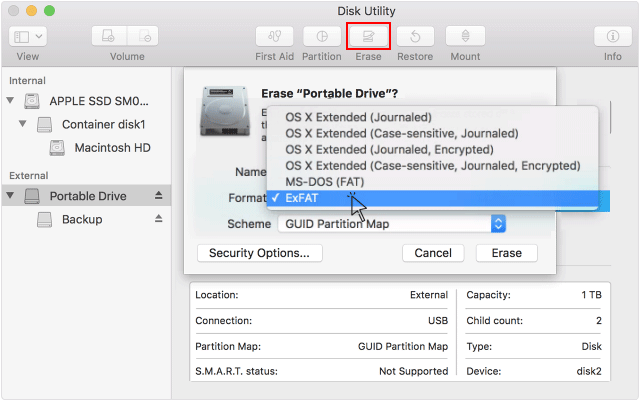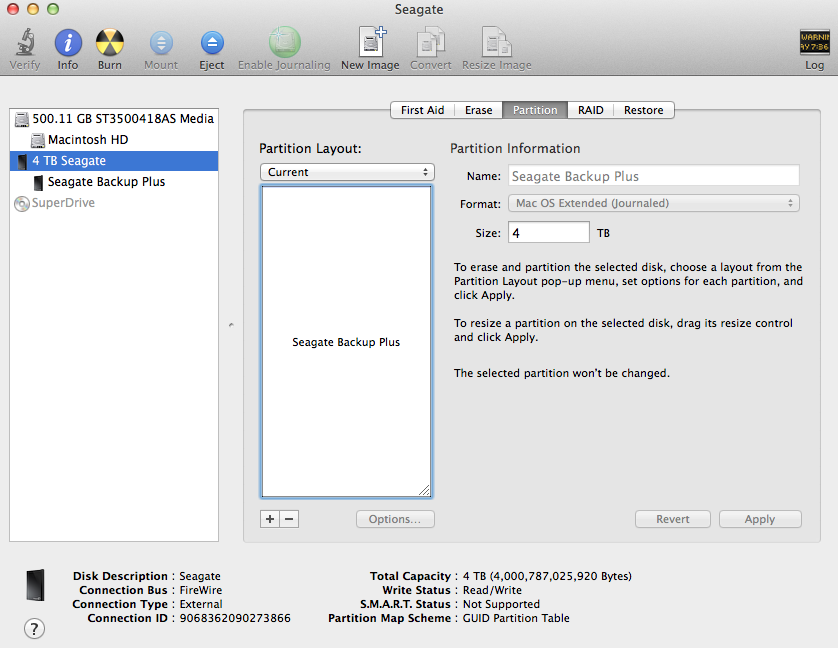Reformat Thumb Drive Mac Os
This simple guide will teach you How to Format a Flash Drive on Mac. Not only this, we will help you pick the best file system for your usb flash drive that you are planning to use on a Mac.
Majority of 49.4% of desktop and laptop computer users in the world use Windows operating system. In contrast, only 27.4% of users use MacOS, obviously for their apple computer. That’s the reason why most of the flash drives in the market are available in Fat32 or NTFS formats which are the most preferred format for windows. Although the first one, Fat32 is completely compatible with both MacOS as well as Windows, it has some limitations. Fat32 can store files only up to 4 GB of size. The latter one, NTFS is mostly used on the Windows operating system and not an optimal option for MacOS. Extra work is needed to use NTFS on MacOS. If you want to use your flash drive solely for MacOS, it is highly recommended to format your flash drive.
Here, pop-ups the question: How to format a flash drive on a mac?
Jan 15, 2014 Insert your USB into the Mac and run the Disk Utility. Select the USB drive that appears in the left-hand menu and select the Partition tab across the top. Select the drop down menu and click on 1 partition. In the format type menu make sure you have Mac OS Extended (Journaled) selected. Jan 15, 2019 To format a USB drive in FAT32 or exFAT: 1. Plug the USB drive into your Mac. Go to ApplicationsUtilities and launch Disk Utility. Click on the USB drive in the sidebar in Disk Utility. Click Erase in the Disk Utility toolbar. Type in a name for the formatted disk. Click on the Format menu and choose either MS-DOS (FAT32) or ExFAT.
Contents
- 1 Before you format a flash drive
- 1.1 Check flash Drive’s File System
- 2 How to format a flash drive on Mac?
Before you format a flash drive


MacOS supports HFS plus file system. HFS stands for Hierarchical File System.
Apple introduced this file system in 1985 to replace the existing Macintosh File System or MFS. HFS filesystem is modified into HFS plus (Modernly called as MacOS Extended). Before you format a flash drive it is suggested to know what file system your flash drive is in.
Check flash Drive’s File System
You don’t need to do anything special to know your flash drive’s file system. There are 2 ways you can do this.
Method 1: Using Finder
Plug in your flash drive. Now open the Finder and look for your USB device. Then right-click on the drive’s name. Select “Get Info” from the list of options opened.
A new window will open. Just to the right of “Format” is your drive’s file system.
Method 2: Using Disk utility app
Open the Disk Utility app from the utility folder available in the application. Your drive will be on the left column of the window. Click on the partition. Here you can check the current format of your flash drive.
If your flash drive’s file system is MS-DOS or ExFAT you can use it as it is without further formatting. But if it is NTFS, format your flash drive to make it completely compatible with MacOS.
How to format a flash drive on Mac?
Disk Utility application in MacOS is the best option to format a flash drive on MacOS. You can launch this app in two ways.
Step 1: Press Space while holding your command button. A search box will open. Type Disk Utility in the search box and press enter. Alternatively, Open the Finder window and select applications on the left sidebar. Navigate to Utilities and then Disk Utilities.
Step 2: Search for your flash drive on the sidebar of the Disk Utility app and select it by clicking on its name.
Step 3: Now Click the “Erase” button which is located just below the title bar of the window which says “Disk Utility”. This will erase your whole drive and make it a single partition.
Here you can change the name of your USB drive if you wish. This name will be visible on other devices as well if you plug your flash drive into them. Just below the Name section, you can see a section called “Format”.
You will need to choose a format option to change your flash drive’s file system. But which format to choose is the big question now! No need to worry. Read the description of each format given below and choose the format of your choice.

Types of filesystems
Mac OS Extended (Journaled)
This format is considered as default file system format of the Mac OS X drives. It also supports OS X Lion, like Versions. This format will allow you to use your flash drive on Mac without any limitations.
With Mac OS Extended (Journaled) format, you can setup OS X startup drive. Make sure you have right files and know how to do it. If you have any issues with a built-in drive you can boot from the external disk. This file system format is highly recommended for MacOS. But you cannot write this flash drive from windows PC once you have formatted it as Mac OS Extended (Journaled). You can read files though.
OS X Extended (Case-sensitive, Journaled)
Go for this type of filesystem if you really need it for some reason. For OS X Extended (Case-sensitive, Journaled), the word “File” is different than “file”. It means it’s case sensitive as the name suggests.
OS X Extended (Case-sensitive, Journaled, Encrypted)
Same as filesystem just mentioned above but of course with encryption.
OS X Extended (Journaled, Encrypted)
To use a flash drive with this filesystem you will have to set up a password & enter it whenever you plug in your drive into any device.
MS-DOS (FAT)
This is just a name for the FAT32 filesystem in Disk Utility application. FAT32 supports to almost all of the operating systems in the world. This allows you to transfer files from one operating system to other. The best thing about this filesystem is its support to video game systems which include Xbox 360 and PlayStation. This filesystem can be called a universal system. The limitation about FAT32 filesystem is it doesn’t allow files which are bigger than 4 GB in size and also you cannot create a startup drive unlike Mac OS Extended (Journaled).
ExFAT
This is a new type of filesystem and it supports MacOS X 10.6.5 and later. It is same as FAT32 but it supports files larger than 4 GB. As this filesystem is relatively new, it does not on relatively older versions of Mac OS X. If you don’t use any older version of the operating system, you can use this type of filesystem.
Use ExFAT for this tutorial if you wish to use your flash drive on windows as well on MacOS.
Step 4: For this tutorial, you can ignore the Scheme option which we use if you wish to boot from your flash drive. Click on erase button to format your flash drive.
Voila! You have formatted your flash drive now. You can eject drive by right-clicking on its name in the left sidebar and click on “Eject”.
Suggested article: How to Reset SMC on Mac?
I hope this article has helped. If you are still facing problems or have doubts on how to format USB drive on Mac, then simply comment below.
Related Posts:
Reinstall from macOS Recovery
macOS Recovery makes it easy to reinstall the Mac operating system, even if you need to erase your startup disk first. All you need is a connection to the Internet. If a wireless network is available, you can choose it from the Wi-Fi menu , which is also available in macOS Recovery.
1. Start up from macOS Recovery
Mac Os Reformat Drive
To start up from macOS Recovery, turn on your Mac and immediately press and hold one of the following sets of keys on your keyboard. Release the keys when you see an Apple logo, spinning globe, or other startup screen.
Command (⌘)-R
Reinstall the latest macOS that was installed on your Mac (recommended).
Option-⌘-R
Upgrade to the latest macOS that is compatible with your Mac.
Shift-Option-⌘-R
Reinstall the macOS that came with your Mac, or the closest version still available.
You might be prompted to enter a password, such as a firmware password or the password of a user who is an administrator of this Mac. Enter the requested password to continue.
When you see the utilities window, you have started up from macOS Recovery.
2. Decide whether to erase (format) your disk
You probably don't need to erase, unless you're selling, trading in, or giving away your Mac, or you have an issue that requires you to erase. If you need to erase before installing macOS, select Disk Utility from the Utilities window, then click Continue. Learn more about when and how to erase.
3. Install macOS
Reformat Thumb Drive Mac Os 10
When you're ready to reinstall macOS, choose Reinstall macOS from the Utilities window. Then click Continue and follow the onscreen instructions. You will be asked to choose a disk on which to install.
- If the installer asks to unlock your disk, enter the password you use to log in to your Mac.
- If the installer doesn't see your disk, or it says that it can't install on your computer or volume, you might need to erase your disk first.
- If the installer is for a different version of macOS than you expected, learn about macOS Recovery exceptions.
- If the installer offers you the choice between installing on Macintosh HD or Macintosh HD - Data, choose Macintosh HD.
Please allow installation to complete without putting your Mac to sleep or closing its lid. During installation, your Mac might restart and show a progress bar several times, and the screen might be empty for minutes at a time.
If your Mac restarts to a setup assistant, but you're selling, trading in, or giving away your Mac, press Command-Q to quit the assistant without completing setup. Then click Shut Down. When the new owner starts up the Mac, they can use their own information to complete setup.
macOS Recovery exceptions
The version of macOS offered by macOS Recovery might vary in some cases:
- If macOS Sierra 10.12.4 or later has never been installed on this Mac, Option-Command-R installs the macOS that came with your Mac, or the closest version still available. And Shift-Option-Command-R isn't available.
- If you erased your entire disk instead of just the startup volume on that disk, macOS Recovery might offer only the macOS that came with your Mac, or the closest version still available. You can upgrade to a later version afterward.
- If your Mac has the Apple T2 Security Chip and you never installed a macOS update, Option-Command-R installs the latest macOS that was installed on your Mac.
- If you just had your Mac logic board replaced during a repair, macOS Recovery might offer only the latest macOS that is compatible with your Mac.
Reformat Mac Drive For Pc
If you can't get macOS Recovery to offer the installer you want, you might be able to use one of the other ways to install macOS.
Other ways to install macOS
Format Flash Drive Mac Os Extended Journaled
- You can also install macOS from the App Store or Software Update preferences. If you can't install macOS Catalina, you might be able to install an earlier macOS, such as macOS Mojave, High Sierra, Sierra, El Capitan, or Yosemite.
- Or create a bootable installer disk, then use that disk to install macOS on your Mac or another Mac.